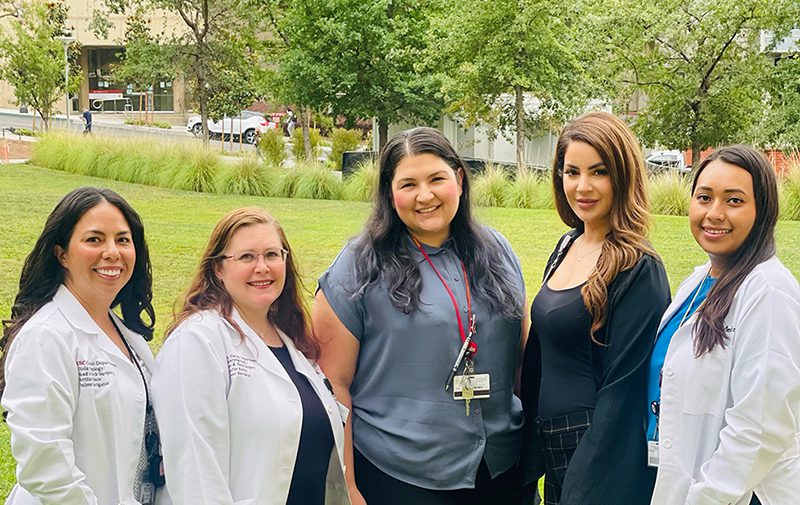Specialized staff play crucial role in treatment of complex ear, nose and throat conditions
By Mollie Barnes

USC Caruso Department of Otolaryngology – Head and Neck Surgery Patient Navigators from left to right: Bettina Ponce, Jennifer Kelley, Monique Gutierrez, Erika Arezomanians, and Maritza Martinez. Photo Credit: Emmanuel Urbano
Most people dream of walking into a new doctor’s office and having one person who will help take care of everything. At the USC Caruso Department of Otolaryngology – Head and Neck Surgery, this dream is a reality.
A patient with a complex case at a typical doctor’s office is usually seen by many different doctors and nurses, all without one person overseeing the coordination all aspects of care. Oftentimes, it’s on the patient to follow up and make sure they’re getting all their necessary appointments and tests for complex medical conditions. But at the USC Caruso Department of Otolaryngology – Head and Neck Surgery, a patient is first contacted by a person who will do just that: a patient navigator. Patient navigators are non-clinical staff who help each patient connect with all the right nurses, doctors, and appointments necessary for the surgical and medical management of head and neck conditions.
“We wear many hats as patient navigators,” says Maritza Martinez, a patient navigator at Keck Medicine of USC. “We are the main point of contact for our patients.”
What does a patient navigator do?
Patient navigators answer questions; assist in appointment coordination and authorizations; obtain medical records; facilitate care with multiple departments, outside medical providers and insurance companies. In addition to that, they also provide a safe space for patients to cry and vent.
“I see many patients with cancer, so a lot of them are scared, sad and upset. Sometimes they just need someone to talk to,” Martinez says. “I have spent nearly an hour on the phone with a patient just letting them vent because they were really upset about their cancer diagnosis.”
One of the most challenging parts of being a patient navigator is explaining their role to people who have never had access to a resource like that before, says Erika Arezomanians, a patient navigator on the team.
“As a team, we contribute to many components within the department,” Arezomanians says. “Our focus is improving workflow, communication, and keeping patients happy. There are many times that we may be asked to help with tasks not necessarily in our scope, but we have to ensure it gets completed because it is important for patient care. I pride myself on making the impossible happen. And as a navigator, you are always challenged with providing innovative solutions for concerns of a patient, physician or clinic staff concerns.”
Navigating a treacherous road
People coming to a specialized center like the USC Caruso Department of Otolaryngology – Head and Neck Surgery often have very complex clinical needs, and the administrative burdens associated with accessing timely care can be overwhelming, says Patient Navigator Monique Gutierrez.
That’s why patient navigators are so important. They deal with coordinating care so that doctors and nurses can focus their time on clinical work. This individualized care and coordination can make a world of difference.
“We can escalate issues, facilitate complex or collaborative clinical services, and provide a level of service to patients that make dealing with their condition a little easier,” Gutierrez says. “We are very accessible—our direct number and emails are widely distributed and given to patients from the time of consult.”
Many patients say they’ve never had access to a resource like that.
“One of the nicest experiences I have had was with a patient that said that he could never have made his decision in his treatment without me,” Arezomanians says. “We continue to speak often, and I continue to assist him in his care in regaining his voice.”
This care is even more personal for Jennifer Kelley. Eight years ago, she was a patient at the USC Caruso Department of Otolaryngology – Head and Neck Surgery, complete with her own patient navigator to help her throughout her treatment. Now she’s a patient navigator herself, as well as the program administrator for the USC Acoustic Neuroma Center.
“That makes me both a really educated patient and navigator,” Kelley says.
What stands out for her is that patient navigators have flexibility to really help with the more complicated patients.
“Having a condition of the head and neck is such a treacherous road, so to be able to change patients’ lives, make them happy and get them on track is really nice,” Kelley remarks.
“I think the diversity of our experience allows us to handle various tasks in providing patient care,” Gutierrez says. “We have great communication amongst our group and readily share ideas and brainstorm challenges.”
“I am very thankful to work with such an amazing group of patient navigators,” Patient Navigator Bettina Ponce says. “We are truly each other’s support system. I couldn’t survive without them.”